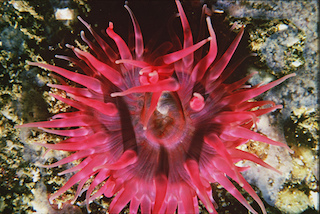 Dahlia Anemones are a common rockpool find on the lower shore.
Dahlia Anemones are a common rockpool find on the lower shore.
Photo: ©Natural England/F Dipper
Scientific name: Urticina felina
What to look for:
• Colouring and appearance: Variable in colour, between grey-white to blues and greens to magenta, and sometimes oranges and yellows. Up to 150+ tentacles and with a debris-covered warty column.
• Size: Up to 10 to 15 cm across
• Where: Lower shore and sublittoral zone
 Occasionally you may be lucky enough to find a rock pool full of this pretty, if rather squat anemone, but more usually you will find it nestled singly beneath seaweed and other debris. You can tell it apart from similar anemones by the banded pattern of markings on the tentacles. They live on a diet of small fish and crustaceans, which they capture and immobilise using the stinging cells in their tentacles.
Occasionally you may be lucky enough to find a rock pool full of this pretty, if rather squat anemone, but more usually you will find it nestled singly beneath seaweed and other debris. You can tell it apart from similar anemones by the banded pattern of markings on the tentacles. They live on a diet of small fish and crustaceans, which they capture and immobilise using the stinging cells in their tentacles.
Did you know…?
…The column (verruca) is usually covered in bits of seashells and stones, making this anemone look something like a small mound of gravel when the tentacles are retracted.
More information and references:
Preston-Mafham, K., 2004. Seashore of Britain and Europe (Collins Nature Guides). HarperCollins Publishers Ltd., London
Turk, S. M., 1971. An Introduction to Sea-shore Life in Cornwall and the Isles of Scilly. D. Bradford Barton Ltd., Truro
Published: April 2016
Author: Amanda Scott
Photos: ©Natural England/F Dipper
